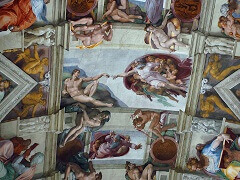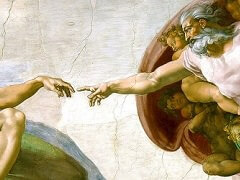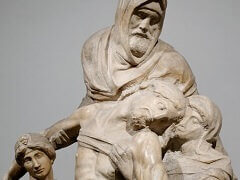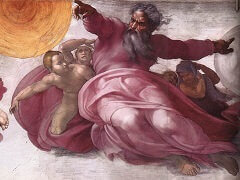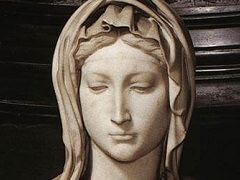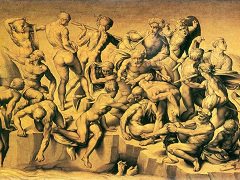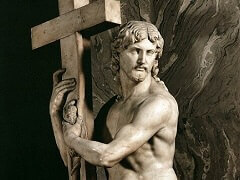Ezekiel, by Michelangelo

A match for his mighty counterpart, The Cumaean Sibyl, but unlike her, deeply excited, the aged Ezekiel, holding an open scroll of prophecy in his left hand, twists in the direction
of the Fall of Man. Like Isaiah, Ezekiel too had a vision not only of the Tree of Life, "whose leaf shall not fade, neither shall the
fruit thereof be consumed . . . the fruit thereof shall be for meat and the leaf thereof for medicine," but also of the Tree of Knowledge, that the deep set up on high, and "under his shadow
dwelt all great nations." This tree shall be cut down, its boughs broken, the peoples of the earth will leave it, it will be "cast down to hell with them that descend into the pit." Nonetheless
the prophet is deflected from his terrible vision of the trees in the Fall of Man by the earnest words of his attendant putto. The child points upward like a
youthful St. John the Baptist to the Creation of Eve, with its Christ-Adam extended below the dry tree, as if to bear the Lord's message, that He would
bring down the high tree and exalt the low, dry up the green tree, and make the dry tree to flourish.
Under his title as the Son of Man, Ezekiel is a type of Christ. He is also one of the principal prophets of the Virgin Birth, by reason of his vision in which an angel brought him before the
gate of the sanctuary. "Then said the Lord unto me; this gate shall be shut, it shall not be opened, and no man shall enter in by it; because the Lord, the God of Israel, hath entered in by
it. . . It is for the prince, the prince, he shall sit in it to eat bread before the Lord ..." Throughout Christian thought and art the closed gate of Ezekiel was taken to signify the virginity
of Mary, and was identified liturgically with the gate of the sanctuary, over which frequently appeared the Annunciation to the Virgin, the very moment of the entrance of divinity into the
sanctuary of Mary's body. It is no accident, therefore, that Ezekiel is placed above the barrier to the sanctuary in the Sistine Chapel, facing the sibyl of the Roman Church and flanking with
her the Creation of Eve, which symbolizes the creation of the Church. It is hardly a surprise to discover the passage describing Ezekiel's vision of the^ closed gate below his picture in
Barbieri's little book dedicated to Sixtus IV, who built the Chapel and commenced its decoration.


